
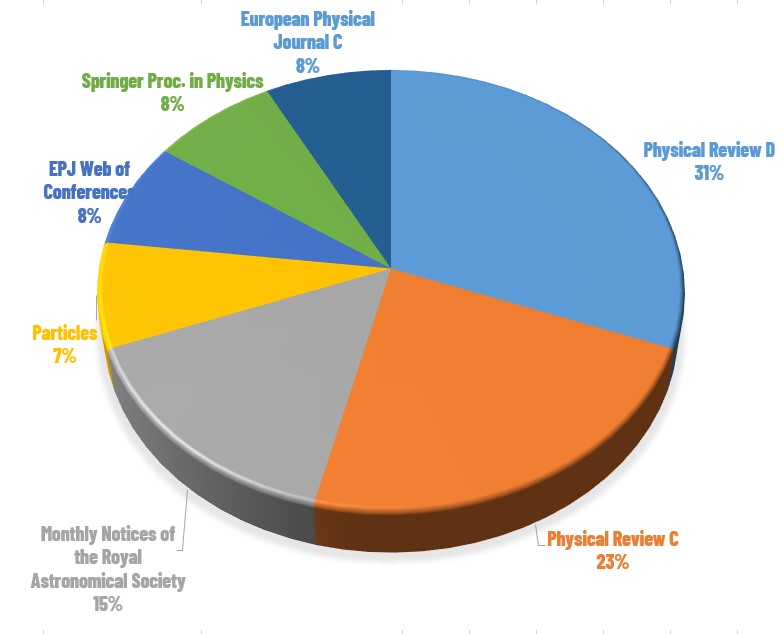
Updated on 25 December 2023
Thapa, V. B., Sarkar, T., & Sinha, M. (2023). Implications of symmetry energy on neutron star cooling. In Proceedings of the 67th DAE Symposium on Nuclear Physics (ISBN: 978-12-345678-9-7) (Vol. 67, p. 783–784). DOI:http://www.sympnp.org/proceedings/67/C6 Sarkar, T., Thapa, V. B. & Sinha, M. (2023). Fast neutron star cooling in light of the PREX-2 experiment. Physical Review C, 108, 035801. DOI:10.1103/PhysRevC.108.035801 Thapa, V. B., Beznogov, M., Raduta, A. R., & Thakur, P. (2023). Frequencies of f- and p-oscillation modes in cold and hot compact stars. Physical Review D, 107, 103054. DOI:10.1103/PhysRevD.107.103054 Kumar, A., Thapa, V. B., & Sinha, M. (2023). Hybrid stars are compatible with recent astrophysical observations. Physical Review D, 107, 063024. DOI:10.1103/PhysRevD.107.063024 Kundu, D., Thapa, V. B., & Sinha, M. (2023). (Anti)kaon condensation in strongly magnetized dense matter. Physical Review C, 107, 035807. DOI:10.1103/PhysRevC.107.035807 Thapa, V. B., & Sinha, M. (2023). Tension between implications from PREX-2 data and gravitational tidal response on dense matter equation of state. In EPJ Web of Conferences (Vol. 279, p. 10003). DOI:10.1051/epjconf/202327910003 Thapa, V. B., Sinha, M., Sedrakian, A., & Li, J. J. (2022). Potentiality of antikaon condensation in dense matter. In Proceedings of the 66th DAE Symposium on Nuclear Physics (ISBN: 978-81-959225-1-2) (Vol. 66, p. 734–735). DOI:http://www.sympnp.org/proceedings Kumar, A., Thapa, V. B., & Sinha, M. (2022). Compact star merger events with stars composed of interacting strange quark matter. Monthly Notices of the Royal Astronomical Society, 513, 3788. DOI:10.1093/mnras/stac1150 Thapa, V. B., Sinha, M., Li, J. J., & Sedrakian, A. (2022). Dense matter in strong magnetic field: Covariant density functional approach. In Springer Proceedings in Physics (Vol. 277, p. 755–759). DOI:10.1007/978-981-19-2354-8_136 Thapa, V. B., & Sinha, M. (2022). Direct URCA process in light of PREX-2. eprint: https://arxiv.org/abs/2203.02272 Thapa, V. B., & Sinha, M. (2022). Influence of the nuclear symmetry energy slope on observables of compact stars with ∆-admixed hypernuclear matter. Physical Review C, 105, 015802. DOI:10.1103/PhysRevC.105.015802 Thapa, V. B., Sarkar, T., & Singha, J. (2021). Probing dense matter equation of state in view of neutron star astrophysical observables. In R. Jayakumar & R. R. Duvvuru (Eds.), Research trends in multidisciplinary research (Vol. 29, p. 41–66). DOI:10.22271/ed.book.1306 Thapa, V. B., Kumar, A., & Sinha, M. (2021). Baryonic dense matter in view of gravitational-wave observations. Monthly Notices of the Royal Astronomical Society, 507, 2991. DOI:10.1093/mnras/stab2327 Thapa, V. B., Sinha, M., Li, J. J., & Sedrakian, A. (2021). Massive ∆-resonance admixed hypernuclear stars with antikaon condensations. Physical Review D, 103, 063004. DOI:10.1103/PhysRevD.103.063004 Thapa, V. B., & Sinha, M. (2020). Dense matter equation of state of a massive neutron star with antikaon condensation. Physical Review D, 102, 123007. DOI:10.1103/PhysRevD.102.123007 Thapa, V. B., Sinha, M., Li, J. J., & Sedrakian, A. (2020). Equation of state of strongly magnetized matter with hyperons and ∆-resonances. Particles, 3, 660. DOI:10.3390/particles3040043
2023
2022
2021
2020

Abstract: The nuclear symmetry energy and its behaviour with density has been recently evaluated with enhanced value by PREX-2 experiment. This new values enables direct Urca neutrino emission process to be functioning in the dense matter inside neutron stars. With this new outlook we study the cooling rate of canonical mass neutron stars and compare with available observational cooling data. We find most of the isolated neutron star thermal profile is compatible with the cooling of canonical mass star including superfluidity suppression. Click the following link for the full paper (arXiv:2308.16449).
Abstract: A large collection of equations of state (EOSs) built within the covariant density functional (CDF) theory of hadronic matter and allowing for density dependent (DD) couplings is employed to study polar f- and p- oscillations of cold and hot compact stars. Correlations between oscillation frequencies of cold purely nucleonic neutron stars (NSs), their global parameters as well as properties of nuclear matter (NM) are investigated by considering a set of models from Beznogov and Raduta, [Phys.~Rev.~C 107, 045803 (2023)], where a number of constraints on the saturation properties of NM, pure neutron matter (PNM) and the lower bound of the maximal NS mass were imposed within a Bayesian framework. The roles of finite temperature and exotic particle degrees of freedom, e.g., hyperons, Δ-resonances, anti-kaon condensates or a hadron to quark phase transition, are addressed by employing a family of models publicly available on CompOSE and assuming idealized profiles of temperature or entropy per baryon and charge fraction. We find that finite temperature effects reduce the oscillation frequencies of nucleonic stars while the opposite effect is obtained for stars with exotic particle degrees of freedom. When the Γ-law is employed to build finite temperature EOSs, errors in estimating oscillation modes frequencies are of the order of 10% to 30%, depending on the mass. Throughout this work the Cowling approximation is used. Click the following link for the full paper (arXiv:2302.11469).
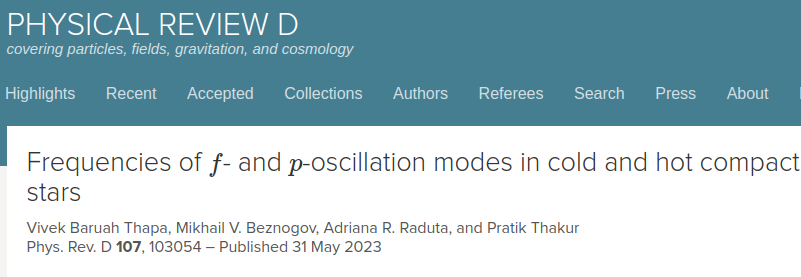

Abstract: Compact stars (CS) are stellar remnants of massive stars. Inside CSs the density is so high that matter is in subatomic form composed of nucleons. With increase of density of matter towards the centre of the objects other degrees of freedom like hyperons, heavier non-strange baryons, meson condensates may appear. Not only that at higher densities, the nucleons may get decomposed into quarks and form deconfined strange quark matter (SQM). If it is so then CSs may contain SQM in the core surrounded by nucleonic matter forming hybrid stars (HSs). However, the nature and composition of matter inside CSs can only be inferred from the astrophysical observations of these CSs. Recent astrophysical observations in terms of CS mass-radius (M-R) relation and gravitational wave (GW) observation indicate that the matter should be soft in the intermediate density range and stiff enough at higher density range to attain the maximum possible mass above 2 M⊙ which is not compatible with pure hadronic equation of states (EOSs). Consequently, we study the HS properties with different models of SQM and find that within vector bag model considering density dependent bag parameter, the model goes well with the astrophysical observations so far. Click the following link for the full paper (arXiv:2303.06387).
Abstract: Recent observations of several massive pulsars, with masses near and above 2 M⊙, point towards the existence of matter at very high densities, compared to normal matter that we are familiar with in our terrestrial world. This leads to the possibility of appearance of exotic degrees of freedom other than nucleons inside the core of the neutrons stars (NS). Another significant property of NSs is the presence of high surface magnetic field, with highest range of the order of ∼ 10^16 G. We study the properties of highly dense matter with the possibility of appearance of heavier strange and non-strange baryons, and kaons in presence of strong magnetic field. We find that the presence of a strong magnetic field stiffens the matter at high density, delaying the kaon appearance and, hence, increasing the maximum attainable mass of NS family. Click the following link for the full paper (arXiv:2210.14565).

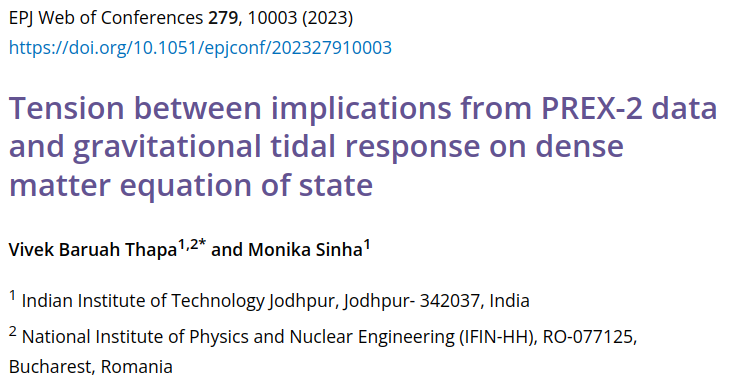
Abstract: Recently an improved value of neutron skin thickness of 208Pb was reported in Lead Radius EXperiment-2 (PREX-2) to be Rskin=Rn−Rp=(0.283±0.071) fm which corresponds to high estimations of nuclear symmetry energy (Esym) and its slope (Lsym). The updated values of Esym and Lsym commensurating to the neutron star observable estimations lie exterior to the astrophysical observed range. The higher values of Lsym at n0 deduced from recent PREX-2 data correlates to matter being easily deformable (yielding higher radius values) around intermediate matter densities leading to higher values of Λ̃ creating a tension between the terrestrial and astrophysical observations. In this study, we exploit this tension to constrain the Δ-scalar meson coupling parameter space. Click the following link for the full paper (arXiv:2302.07726).
Abstract: We investigate the properties of stars participating in double compact star merger events considering interacting model of stable strange quark matter. We model the matter making it compatible with the recent astrophysical observations of compact star mass-radius and gravitational wave events. In this context we consider modified MIT bag model and vector bag model with and without self interaction. We find new upper bound on tidal deformability of 1.4 M⊙ strange star corresponding to the upper bound of effective tidal deformability inferred from gravitational wave event. Range of compactness of 1.4 M⊙ strange star is obtained as 0.175≤C1.4≤0.199. Radius range of 1.5M⊙ primary star is deduced to be 10.57≤R1.5≤12.04 km, following stringent GW170817 constraints. GW190425 constraints provide with upper limit on radius of 1.7 solar mass strange star that it should be less than 13.41 km. Click the following link for the full paper (arXiv:2204.11034).
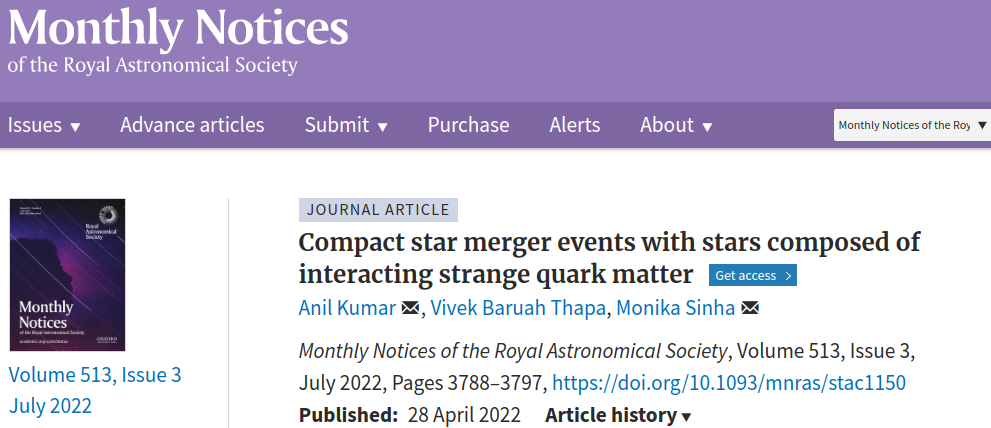
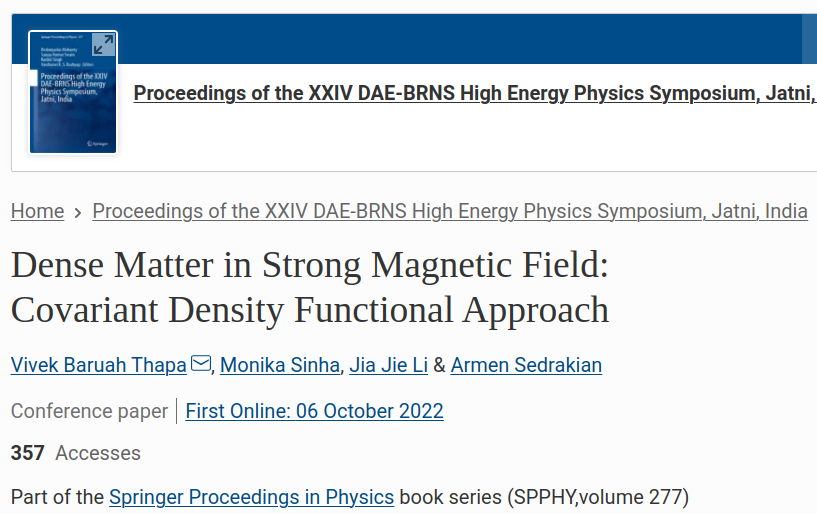
Abstract: The existence of compact stars with high mass (>2𝑀⊙ ) raises the possibility of the appearance of heavy baryons at high-density regimes. With this possibility, we study the effect of a strong magnetic field on the matter composed of baryon-octet and Δ -resonances under strong magnetic fields. The functionals in the hyperonic sector are constrained by the Λ,Ξ− hypernuclei data from terrestrial experiments. Δ-resonance sector is constrained by studies of their scattering off nuclei and heavy-ion collisions. The main effect of the magnetic field is shown to be the oscillations of various matter properties, viz., particle populations and Dirac effective mass with density resulting from the occupation of the Landau level by charged fermions in strong magnetic fields. Click here for the full paper.
Abstract: In this work, we study the effects of nuclear symmetry energy slope on neutron star dense matter equation of state and its impact on neutron star observables (mass-radius, tidal response). We construct the equation of state within the framework of covariant density functional theory implementing coupling schemes of non-linear and density-dependent models with viability of heavier non-nucleonic degrees of freedom. The slope of symmetry energy parameter (Lsym) is adjusted following density-dependence of isovector meson coupling to baryons. We find that smaller values of Lsym at saturation favour early appearance of Δ-resonances in comparison to hyperons leading to latter's threshold at higher matter densities. We also investigate the dependence of Lsym on tidal deformability and compactness parameter of a 1.4 M⊙ neutron star for different equation of states and observe similar converging behaviour for larger Lsym values. Click the following link for the full paper (arXiv:2112.12629).
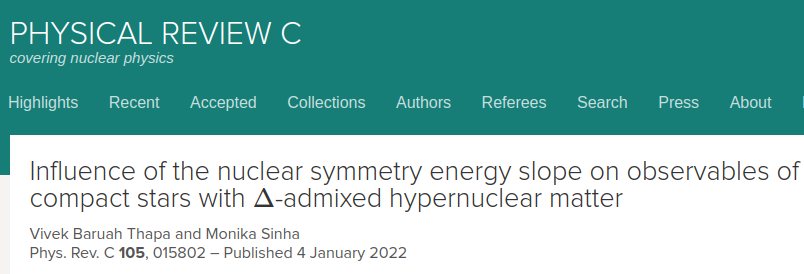
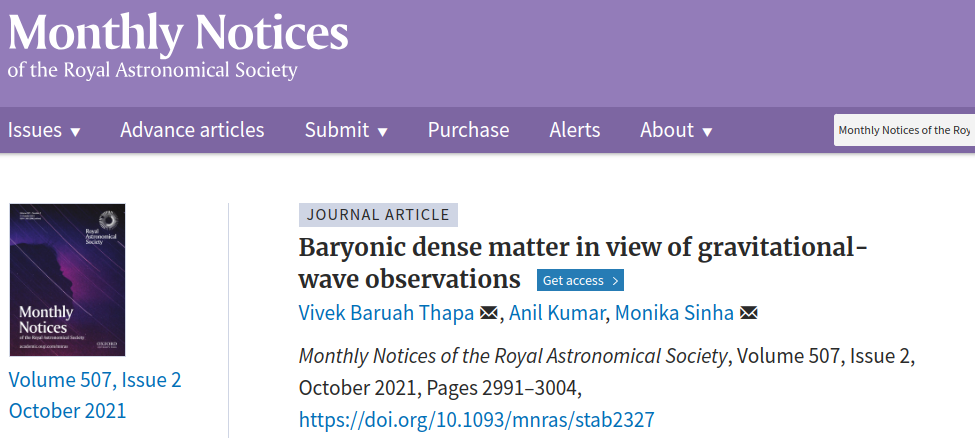
Abstract: The detection of gravitational waves (GWs) from the merger of binary neutron star (NS) events (GW170817 and GW190425) and subsequent estimations of tidal deformability play a key role in constraining the behaviour of dense matter. In addition, massive NS candidates (∼2 M⊙) along with NICER mass–radius measurements also set sturdy constraints on the dense matter equation of state. Strict bounds from GWs and massive NS observations constrain the theoretical models of nuclear matter comportment at large density regimes. On the other hand, model parameters providing the highly dense matter response are bounded by nuclear saturation properties. This work analyses coupling parametrizations from two classes based on covariant density functional models: non-linear and density-dependent schemes. Considering these constraints together, we study possible models and parametrization schemes with the feasibility of exotic degrees of freedom in dense matter which go well with the astrophysical observations as well as the terrestrial laboratory experiments. We show that most parametrizations with non-linear schemes do not support the observations and experiments while density-dependent scheme goes well with both. Astrophysical observations are well explained if the inclusion of heavier non-strange baryons is considered as one fraction of the dense matter particle spectrum. Click the following link for the full paper (arXiv:2108.04318).
Abstract: In this work, we study the effect of (anti)kaon condensation on the properties of compact stars that develop hypernuclear cores with and without an admixture of Δ-resonances. We work within the covariant density functional theory with the parameters adjusted to K-atomic and kaon-nucleon scattering data in the kaonic sector. The density-dependent parameters in the hyperonic sector are adjusted to the data on Λ and Ξ− hypernuclei data. The Δ-resonance couplings are tuned to the data obtained from their scattering off nuclei and heavy-ion collision experiments. We find that (anti)kaon condensate leads to a softening of the equation of state and lower maximum masses of compact stars than in the absence of the condensate. Both the K− and K¯0-condensations occur through a second-order phase transition, which implies no mixed-phase formation. For large values of (anti)kaon and Δ-resonance potentials in symmetric nuclear matter, we observe that condensation leads to an extinction of Ξ−,0 hyperons. We also investigate the influence of inclusion of additional hidden-strangeness σ∗ meson in the functional and find that it leads to a substantial softening of the equation of state and delay in the onset of (anti)kaons. Click the following link for the full paper (arXiv:2102.08787).
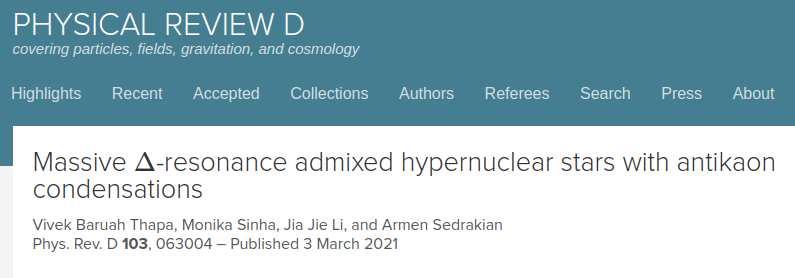
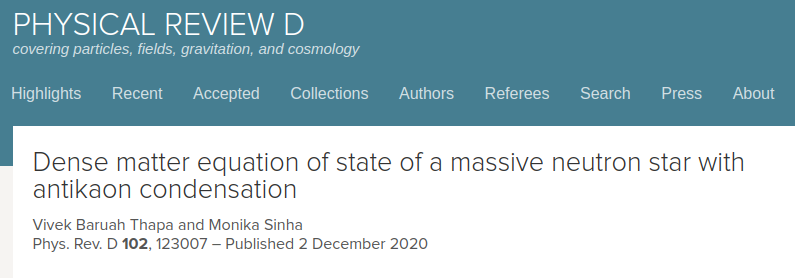
Abstract: Recent measurements of neutron star mass from several candidates (PSR J1614 − 2230, PSR J0348 + 0432, MSP J0740 + 6620) set the lower bound on the maximum possible mass for this class of compact objects ∼2 M⊙ . Existence of stars with high mass brings the possibility of existence of exotic matter (hyperons, meson condensates) at the core region of the objects. In this work, we investigate the (anti)kaon (K − , K̄ 0 ) condensation in β-equilibrated nuclear matter within the framework of covariant density functional theory. The functionals in the kaonic sector are constrained by the experimental studies on K − atomic, kaon-nucleon scattering data fits. We find that the equation of state softens with the inclusion of (anti)kaon condensates, which lowers the maximum mass of neutron star. In one of the density- independent coupling cases, the K − condensation is through a first order phase transition type, which produces a 2 M⊙ neutron star. The first order phase transition results in mixed phase region in the inner core of the stars. While K̄ 0 condensation appears via second-order phase transition for all the models we consider here. Click the following link for the full paper (arXiv:2011.06440).
Abstract: We construct a new equation of state for the baryonic matter under an intense magnetic field within the framework of covariant density functional theory. The composition of matter includes hyperons as well as ∆-resonances. The extension of the nucleonic functional to the hypernuclear sector is constrained by the experimental data on Λ and Ξ- hypernuclei. We find that the equation of state stiffens with the inclusion of the magnetic field, which increases the maximum mass of neutron star compared to the non-magnetic case. In addition, the strangeness fraction in the matter is enhanced. Several observables, like the Dirac effective mass, particle abundances, etc. show typical oscillatory behavior as a function of the magnetic field and/or density which is traced back to the occupation pattern of Landau levels. Click the following link for the full paper (arXiv:2010.00981).
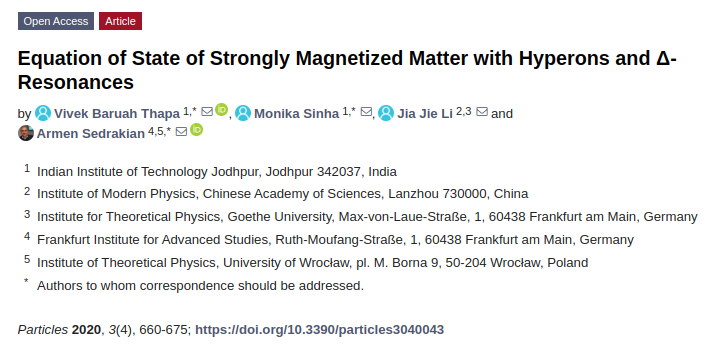
Contact Me
Address of correspondence
Room No.-21, Department of Physics,
Bhawanipur Anchalik College,
Barpeta, Assam-781352, India
thapa.1@iitj.ac.in, vbthapa1@gmail.com
